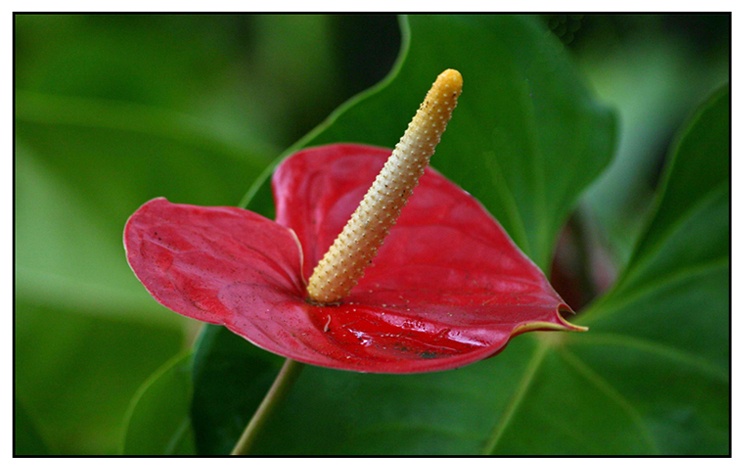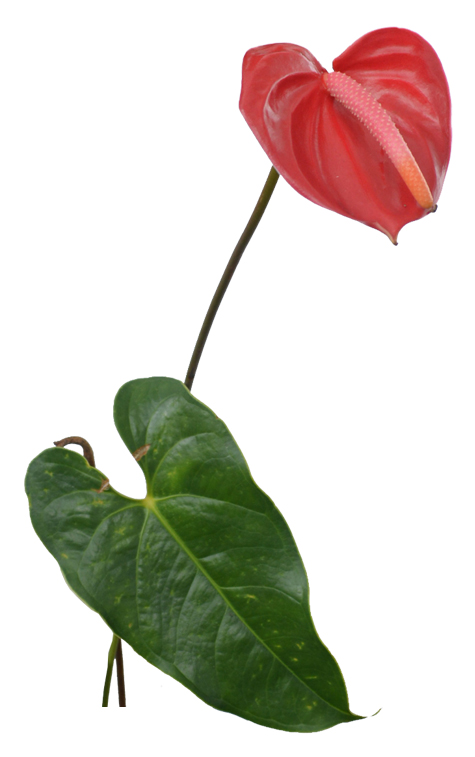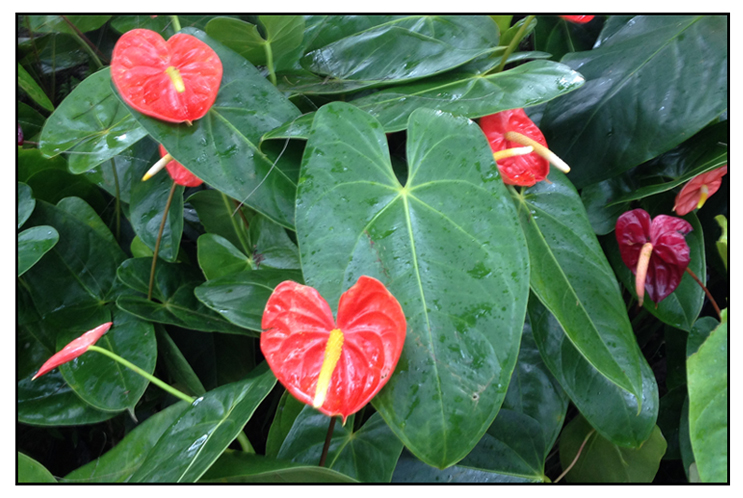General info
- Anthurium is the national flower of Mauritius. It ranks ninth in the global flower trade. (4)
- Anthurium is second, only to orchid, among tropical cut flowers. It is a member of the family Araceae which consists of 108 genera and approximately 3750 monocotyledonous species. (6)
- It is one of the plants listed in the NASA Clean Air Study as effective in removing formaldehyde, xylene, toluene, and ammonia from the air. (see study below)
(1)
- Etymology: The name derives from Greek words anthos, meaning flower, and oura, meaning a tail, referring to the spadix.
(1)
Botany
Anthurium is an evergreen perennial plant that can grown to a meter in height. Leaves are large, dark, glossy, oblong or heart-shaped, up to 30 centimeters in length. Each leaf is held on a 30 to 60 centimeter petiole. Flowers are slender, finger-like or tail like spadix above a shiny, waxy, crinkled, heart-shaped spathe, red to bright orange.
 Distribution Distribution
- Introduced.
- Ornamental cultivation.
- Grows well in the Baguio area.
- Popular pot or cut flower because of its longevity.
- Native to Columbia, Ecuador.
Constituents
- Study of various plant parts for phytoconstituents yielded alkaloids, flavonoids, phenols, phlobatannins, steroids, and tannins. (see study below) (8)
- Study of leaves isolated three flavone 6-C-glycosides. Two new flavones were identified through spectroscopic analysis as 4" '-(3,4-dimethoxycinnamoyl)-embinin (2) and 4" '-ferruloyl-embinin (3). (16)
Toxicity concerns
- Whole plant, especially the sap, yields calcium oxalate crystals. Also contains proteolytic enzymes that can induce histamine release and cause allergic reactions in sensitive individuals. (2)
- Leaves and stems contain minute, sharp crystals, or raphides of calcium oxalate that can cause swelling and burning of the lips, mouth, and throat, and sometimes, difficulty swallowing and breathing.
The calcium oxalate crystals can also cause irritation of the skin and eyes. (2)
- Occasional reports of intense eye and skin itching when in close proximity, without actual contact, raising the possibility of airborne allergens.
P roperties roperties
- Plant components known to cause allergic reactions.
- Considered antimicrobial, air-filtering.
- Studies have suggested air-cleaning, antibacterial, antifungal, anticancer properties.
Parts used
Flowers, leaves.
Uses
Folkloric
- In La Union, Philippines, indigenous peoples drink leaf decoction for kidney diseases. (10)
- Elsewhere, flower ash reportedly used to treat boils.
- Crushed leaves rubbed on caterpillar sores.
- In China, reportedly used for rheumatic pains.
- A Belize healer reports on the use of anthurium in stem for discomforts of arthritis and rheumatism: Leaves are cut and boiled in a pot, and the user seats over it with a blanket. Poultice also used for muscle aches and cramps: Leaves are wrapped around the neck and back.
Studies
• Air-Filtering: In the NASA Clean Air Study, Anthurium adraeanum is in the list of indoor plants that may remove toxic agents from the air, helping neutralize the effects of sick building syndrome. As an air-filtering plant, anthurium removes formaldehyde, ammonia, xylene and toluene. (1)
• Formaldehyde Removal: Anthurium andraeanum was in the top 15% of 40 woody and herbaceous foliage plants tested for formaldehyde removal. (5)
• Antimicrobial / Flowers, Stems, Leaves and Roots: Study evaluated the phytochemical constituents and antimicrobial activity of different solvent extracts of flowers, leaf, stem, and roots of A. andraeanum. The extracts sowed inhibitory activity against tested pathogens, with significant inhibition of gram negative bacterial strains of E. coli and K. pneumonia and fungal pathogen A. fumigatus. Flower extract showed superior zone of inhibition against A. fumigatus and E. coli. (8)
• Anticancer Compounds: Study of A. andraeanum isolated a purified bioactive compound that was found to be effective against test cell lines (HepG2, A549, and MCF7). Gas chromatography and mass spectrophotometer analysis revealed the presence of anticancer compounds such as 2,3-dihydro-benzofuran and stimasta-5,20(22)-dien-3-ol. (9)
• Color / Spathe and Spadix: Study investigated color in A. andraeanum spathe and spadix at a molecular level. Heterologous screening isolated full-length clones for the flavonoid biosynthetic genes, chalcone synthase, flavanone 3-hydroxylase, dihydroflavonol 4-reductase (DFR), and anthocyanidine synthase. Expression patter of the genes implicates DFR as prime regulatory target in the spathe, having an independent regulatory mechanism to that of the other genes. In the spadix, other regulatory targets are suggested. (11)
• Silver Nanoparticles / Antibacterial / Leaves: Study reports on the green synthesis of silver nanoparticles using the leaf extract of Anthurium andraeanum. Antibacterial and biofilm inhibition activity were assessed. At 1 mg/mL, the AgNPs showed antibacterial activity against all bacterial strains tested. In antibiofilm activity study, highest inhibition percentage was against P. fluorescen strain at 87.1% at concentration of 0.5 mg/mL. (14) Study evaluated the bactericidal activity of AgNPs obtained from A. andraeanum against bacteria: Enterobacter aerogenes, Salmonella infantis, S. typhimurium, Escherichia coli, Enterococcus faecalis, Staphylococcus aureus, S. epidermis, and Bacillus epidermis. MIC and MBC showed minimum inhibitory concentration against all species was 0.125 mg/mL, while bactericidal effect for all strains was 1 mg/mL except for S. aureus. (17)
• Vitexin: Vitexin (apigenin-8-C-ß-D-glucopyranoside) is a flavonoid that has been found in Anthurium andraeanum. Early studies have shown vitexin to have hypotensive, anti-inflammatory, and anticancer properties. In vivo studies verified that vitexin was protective against myocardial I/R damage in rat heart, which was attributed to its antioxidation ability and lowering of levels of inflammatory cytokines. (15)
Management of Oxalate Poisoning
• Symptoms: Ingestion can cause painful irritation and blistering of the mouth and throat, hoarseness and dysphagia.
• Prehospital Care: Decontaminate mouth, eye, and skin by physically removing all plant material. Treat eye and skin exposure with copious water irrigation. (3)
• Emergency Department Care: Remove any plant material from the oral cavity. If airway compromise is ruled out, patient may be allowed to drink cold liquids, eat crushed ice, or frozen desserts for relief. Oral swishing of diphenhydramine elixir may provide anesthetic and antihistamine effects. Laryngeal edema should be treated with antihistamines. No data supports the use of steroids for laryngeal edema caused by oxalate-containing plants. (3)
Note: Anthurium andraeanum's air-filtering property seems to be negated by the risk of calcium oxalate exposure.
Availability
- Cultivated.
- Seeds in the cybermarket.
|


![]()




 roperties
roperties